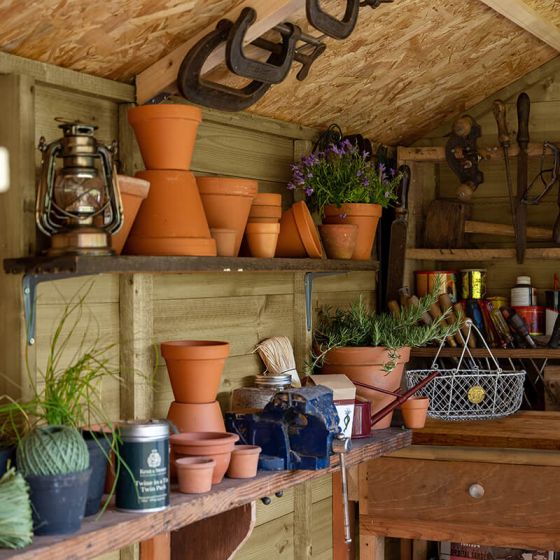From the potting shed with Chris Milborne
From the potting shed...

Our monthly gardening newsletter, written by our Great Amwell plant department colleague, Chris Milborne.
September is glorious in the garden and even though the days may be getting shorter and the sun is lower in the sky, it still casts a wonderful light on the flowers of Rudbeckias Heleniums, Echinaceas, Japanese Anemones.
Beautiful grasses, especially Miscanthus and a favourite, Miscanthus nepalensis, display the fluffy plumes of their flower and the leaves turn from green to bronze shades. Bronze Fennel with its yellow flowers, feathery foliage and seed heads are so attractive amongst flowering Herbaceous perennials.
The vibrant flowers of Cosmos, Zinnias, Tithonias and beautiful Dahlias all seem to improve through to the first frosts. The secret to keep flowers looking their best is regular dead heading - a weekly or even daily task, and regular feeding. Tomato feed high in Potash is ideal to keep flower buds coming. If you read the gardening books of around 50 to 60 years ago, you will know that September was the time when gardeners were preparing for the first frosts and putting the garden to bed for the year, but not anymore. There are still a few glorious months of gardening to come and enjoy. The Summer holidays may be over but there are still lots of gardening jobs to do.
You may notice at this time of the year the garden lacks interest so now is a good time to make changes to the garden. In the Spring there are so many flowering plants available but by mid-July their colour fades, so plan to fill approximately a third of your border with late summer plants. For inspiration and design ideas visit garden shows or visit the many gardens that are open and ask for advice in your local garden centre.
Take a good look at your garden and see how it has coped with the summer weather. To enable plants to grow stronger and healthier during the summer, especially when growing roses and herbaceous perennials, I have found the following treatment very effective. Use a mulch of garden compost or well-rotted farm yard manure and combine this with feeding the soil with a fertilizer a granular fish, blood and bone to start and then in late summer use a liquid tomato sea weed feed.
The weather conditions this year has also been very helpful to support good growth. Avoid feed with high Nitrogen levels as this produces verdant lush growth but requires more watering. Where I have grown ground cover plants under a taller plant canopy, this helps to keeps the soil cooler and can also reduce weed growth.
Planted tubs and containers did better when grouped together and also provides a greater impact as this seems to make the plants stand out rather than individual pots and containers. Being in groups also keeps the heat of the sun from the pots keeping the roots cooler which is especially important when growing Acers, Camellias Hydrangeas, Rhododendrons, Azaleas and other plants such as Honeysuckles that originate from cooler woodland habitats. In groups the containers don't dry out so quickly and together with regular feeding and dead-heading they have looked brilliant all Summer.
Create a compost heap
Now is a perfect time to start a compost heap as there will be plenty of garden waste during Autumn such as plant material produced from grass clippings, to old summer bedding. Autumn pruning and crop remains from the vegetable patch that is well rotted down produces beneficial compost to the soil.
To make successful compost you need three things:
- Firstly, you need bulky natural ingredients such as annual weeds, fallen leaves, vegetable peelings, lawn clippings, unprinted paper and cardboard. Avoid woody stems, perennial weeds and plants with diseases.
- Secondly, a beneficial bacterium that activates the compost is required. This can be from farmyard manure, garden soil or compost activator.
- Thirdly, moisture is needed to keep the compost damp so remember to water it in dry weather
Plant a Tree
As we head towards Autumn, think about planting a tree for the garden. Ornamental or fruit trees are so important for any garden whatever the size and space available, giving structure and a backbone to the garden.
Trees provide so much interest whether in leaf shape and colour, or if it flowers or fruits and can add Autumn colour. Small trees, especially fruit trees, are great for growing in containers if space is limited. As they grow, they also provide shade in the summer sunshine providing a natural environment for many smaller shade loving plants to grow plus they create habitats for wildlife.
Autumn is a good time to plant trees and shrubs as the soil is warm from the summer and autumn rainfall keeps the soil moist enabling plants to establish a good root system before the colder conditions of January and February. Plants get off to a better start if planted now rather than planting in late winter.
When planting your tree, soak the root ball prior to placing it in the hole (preferably a square hole rather than round as this has been found to encourage better root development). Improve the soil taken from the hole with a feed of bone meal then replace the soil and firm in. Make sure the tree is planted at the same level when grown in the pot, if it's in a windy position stake but remove this after 18 months.
Once planted, thoroughly water and finally mulch with a good organic compost. Trees and shrubs can take a year to establish a good root system so it is important to keep well-watered over this time. This is especially important today as the root ball, in peat free compost, can easily dry out.
Start Planning for Spring
Gardeners are always looking forward to the next season and although Spring might seem a long way off, now is the time to start planting spring bulbs. This year the soil is a lot better for planting due to the weather conditions we have had.
Choose from small Snow Drops, Crocus to metre-high Crown imperial Fritillaria or delightful Daffodils or Narcissis grown in gardens for 2,000 years and thought to have been introduced to Britain by the Romans from perhaps Spain and Portugal. The range from small miniatures to large trumpet Daffodils, such as old favourites like Fortune and King Alfred, followed by the amazing range of Tulips that flower from April to May. These come in all shades of colour and are best plated in late October and November. In the flower beds, Alliums and Camassias extend the spring show further.
Daffodils, depending on the variety, will flower from Jan to April. Plant some under your newly planted tree to provide bright colours - a welcome sight for Spring. Daffodils and Narcissus are some of the easiest plants to grow returning every year whether in beds and borders, naturalising amongst shrubs and herbaceous plants or planted in lawns. They also grow well in tubs and containers providing beautiful flowers and many have a fragrance too. For impact when planting tubs and containers, choose for early, middle or late flowering, either - similar variety or go for a mixed ‘layering’ planting style. When selecting colours think of the 'colour wheel but I find it interesting to mix it up a bit.
To help make the choice there are colour co-ordinated packs, mixed packs for ‘Lasagne’ planting and even a ready-to-plant mats are available if you uncertain what to do.
By growing bulbs in tubs and containers they can be moved when in flower to stand by the front door, on the patio or stood in the middle of borders. Then as the flowers go over the tubs can be moved out of sight to die down naturally and replace with the next container coming into flower.
When growing bulbs in pots use a multipurpose compost plus additional grit for drainage, keep the compost damp and increase watering when actively growing. Start feeding every 2 weeks with a high potash tomato feed when shoots appear.
During Autumn squirrels can be a problem with crocus and Tulip bulbs. Cover the area they are planted in with chicken wire or chop up hot chilli peppers and scatter on the surface.
Look after your lawn
After the summer, September is the time to start improving and maintaining the lawn. With the damper conditions and warmth of this summer, grass is actively growing and unlike previous years, is still very green. Start by 'Scarifying" using a lawn rake to remove any moss or thatch which is just an accumulation of dead grass and moss built up over the summer months. Also, remove creeping stems of weeds. The 'thatch acts as a barrier to light getting to the grass and also slows down drainage. Afterwards the lawn often looks brown and untidy but will quickly grow and return to green. After scarifying, mow the lawn to remove any further loose grass and stems.
If the soil is soft and damp then spike with an ordinary garden fork making holes 8 - 10 cm deep (3-4m) and every 15 cm (6in) all over the lawn. This helps to alleviate compaction and helps prevent bad drainage during wet winters. Then apply an Autumn Lawn feed high in potash which improves the root growth over winter rather than lush green growth.
Repair broken lawn edges and sort any bumps and hollows. With any bald patches sow some grass seed from mid-September to October. With the warm damp soil conditions, the seed germinates within 7- 10 days.
General Gardening jobs
Whatever the season there are always garden maintenance jobs to do, including dead heading and tidying. Roses have looked stunning this year with good growing conditions and have generally been less stressed resulting in fewer black spot and rust.
As summer bedding comes to an end, replace with plants for winter and spring in your tubs, containers and hanging baskets and try a combination of evergreen shrubs for further interest. Winter foliage of herbaceous perennials such as the colourful leaves of Heucheras and Hellebores, evergreen grasses and winter bedding such as Chrysanthemums, Cyclamen, Pansies, Violas and Wall Flowers. These make colourful additions and under plant with dwarf spring flowering bulbs and ivy to cascade over the edges of your containers or use variegated, thyme.
Evergreen ferns with glossy green foliage also make a useful addition to containers. When replanting summer containers to Autumn/Winter interest pot up plants such as Fuchsias, Geraniums and Lantana. Grow them on in a greenhouse where the extra warmth and protection keeps theme flowering until November. With the mild Autumn last year, I had some in flower to near Christmas time. If they are placed in a greenhouse and protected from the frost, they can be over-wintered for earlier flowering plants next year.
Clip hornbeam, beach hedging and trim slow-growing yew and box hedges, not forgetting privet and Lonicera nitida that will need a final cut before the end of the season.
Sow Sweet Pea in a cold frame or greenhouse for earlier blooms next year.
Sow hardy annuals such as Calendula, Limnanthus, Poppies, Nigella, Centaurea and Ammi majus. The latter produces white cow parsley like flowers and the seeds can be sown directly in the soil. When grown amongst other perennials and shrubs they also add colour. With a careful sowing regime and planting combinations you can increase the length of the flowering season and provide colour from May to late Autumn.
Harvest the vegetable crop
September is the month for harvesting tomatoes peppers, beans, courgettes, marrows, sweet corn, onions and potatoes. With tomatoes remove the lower leaves to allow the sun to ripen the fruit producing better flavours rather than trying to ripen fruit indoors. Sow broad beans -Aguadulce Claudia is a good variety for Autum sowing. Plant garlic cloves and sow perpetual spinach Rocket, Lambs lettuce and overwinter lettuce which often grows more reliably in a green house, cold frame on polytunnel with that extra protection. Prune and train Logamberes Tayberries and blackberries - the stems that grow this year will produce fruit next year. The canes that fruited this year cut down to just above ground level. then tie in the new shoots to keep plants neat and tidy.
Grow some fresh herbs in pots for Winter such as mint, chives, basil and parsley. They all grow well on a kitchen window sill.
The colour and charm of many late flowering plants together with the late summer sun lower in the sky and some early morning mist, provides a wonderful backdrop to this month’s plant highlights. Perennial grasses with green or golden foliage and plumes of seedheads like Stipa tensissima small clump forming has feathers plumes or Stipen giganten with long streams of golden oats look wonderful in the sun or Pennisetums that seem to have spectacular seed heads that look like furry tails on sticks! Grasses work particularly well will Heleniums Rudbeckias, Echinaceas and Coreopsis on grow with Asters that have daisy-like flowers in pinks, purples and blues.
Shrubs providing interest include Buddlaia so loved by butterflies but keep dead heading, Caryopteris, Hardy Fuchsia, Potentilias, Hibiscus syriacus, Hydranqueno, Escalonias, Hebes and Perovskias (Russian Sage) with sage scented leaves and silver stems with spires of violet blue flowers are a good plant for Mediterranean style gardens growing wall with Lavenders, Olives, Citrus.
Japanese anemones originate from Asia and like so many other garden plants from China and have been grown in Europe since the 19th century. They come in many varieties, available in pinks and whites. They are tall and elegant and the flowers all face the same way towards the light and grow well in any well drained soil in sun or light shade and can take a year or so to establish a good size plant.
Sedums or Hylotelephiums are commonly known as the ‘Ice plant’ and are drought tolerant with late summer flowers that attract bees and butterflies. Depending on variety, some have sprays of pink flowers but otherwise are deep or pale pink and white. Some varieties have colourful purple foliage too.
Cyclamen hederifolium is an autumn flowering hardy cyclamen with dainty flowers in whites and pink that open before the leaves appear. It self-seeds early in wall drained soil in light shade. The seeds are actually distributed by ants!
Until next month take time to stand back and enjoy the colours and flowers of the early autumn garden.


